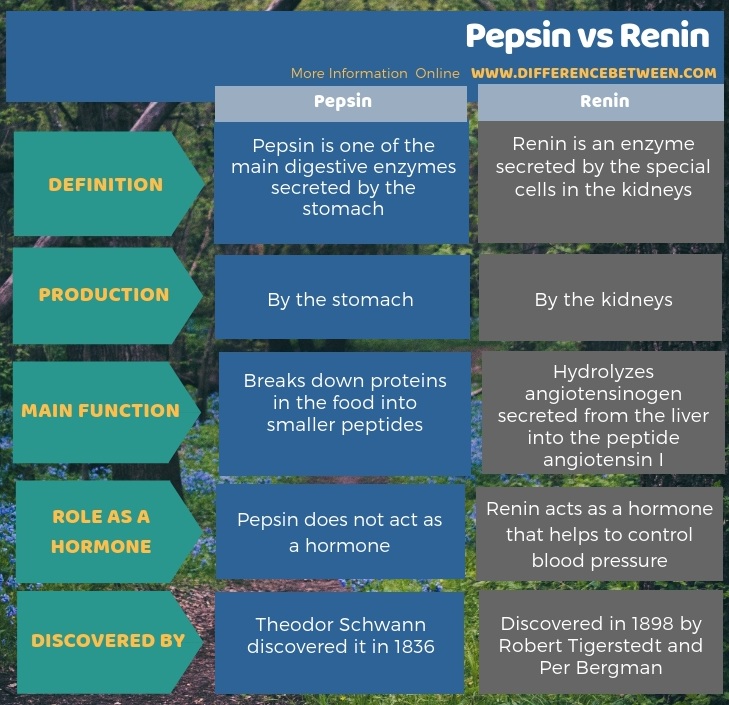The key difference between pepsin and renin is that pepsin, which is one of the main digestive enzymes, is a protease secreted by the stomach while renin is an enzyme and also a hormone produced by juxtaglomerular cells of the kidney.
Proteases are enzymes that hydrolyze peptide bonds and break down proteins into peptides or amino acids. Pepsin is a protease present in the gastric juice. It is one of the main digestive enzymes that break proteinaceous foods into peptides and amino acids. In contrast, renin is an enzyme and an aspartic protease. It is the initiative enzyme of the renin-angiotensin system. Renin works as a hormone and helps to control blood pressure.
CONTENTS
1. Overview and Key Difference
2. What is Pepsin
3. What is Renin
4. Similarities Between Pepsin and Renin
5. Side by Side Comparison – Pepsin vs Renin in Tabular Form
6. Summary
What is Pepsin?
Pepsin is an efficient protease enzyme. It is the main enzyme present in the gastric juice. Theodor Schwann discovered it in 1836. Pepsin has a three-dimensional structure. It hydrolyzes peptide bonds between hydrophobic and aromatic amino acids such as phenylalanine, tryptophan, and tyrosine, etc. Pepsin has a catalytic aspartic group in its active site. Pepsinogen is the inactive form of pepsin.

Figure 01: Pepsin
Stomach HCl converts pepsinogen into active pepsin. Under the acidic environment in the stomach, pepsin cleaves proteins into peptides or amino acids. High alkaline conditions and certain inhibitors such as pepstatin, sucralfate, etc. can block pepsin enzyme successfully.
What is Renin?
Renin is an enzyme secreted by the special cells in the kidneys. It is an aspartic protease. Robert Tigerstedt and Per Bergman discovered renin for the first time.

Figure 02: Renin
It helps to regulate blood pressure by acting as a hormone as well. When the blood pressure drops, renin comes to the bloodstream and triggers the conversion of angiotensinogen to angiotensin I. Angiotensin-converting enzyme catalyzes the conversion of angiotensin I into angiotensin II. Angiotensin II constricts blood vessels to increase blood pressure. Furthermore, angiotensin II stimulates adrenal glands to produce aldosterone. Aldosterone hormone increases the salt level in the blood, thereby increasing the blood pressure.
What are the Similarities Between Pepsin and Renin?
- Pepsin and renin are two proteases.
- Moreover, both are aspartic protease
What is the Difference Between Pepsin and Renin?
Pepsin and renin are proteases that break proteins into simple molecules. Pepsin is the principal digestive protease in the stomach. In contrast, renin is the initiative enzyme of the renin-angiotensin system that helps to control blood pressure. So, this is the key difference between pepsin and renin. The stomach secretes pepsin while juxtaglomerular cells of the kidney produce renin. Another difference between pepsin and renin is that renin acts as a hormone that helps to control blood pressure while pepsin does not act as a hormone.
The below infographic summarizes the difference between pepsin and renin.

Summary – Pepsin vs Renin
Pepsin is the principal acid protease of the stomach. In contrast, renin is the initiative enzyme of the renin-angiotensin system. Special cells in the kidneys secrete renin into bloodstream. Pepsin breaks down proteinaceous food into amino acids while renin helps to regulate blood pressure by cleaving angiotensinogen into angiotensin I. So, this summarizes the difference between pepsin and renin.
Reference:
1. Persson, Pontus B. “Renin: Origin, Secretion and Synthesis.” The Journal of Physiology, Blackwell Science Inc, 1 Nov. 2003, Available here.
2. “Pepsin.” Pepsin – an Overview | ScienceDirect Topics, Available here.
Image Courtesy:
1. “1PSO” By DrKjaergaard assumed. Own work assumed (based on copyright claims) (Public Domain) via Commons Wikimedia
2. “PDB 2ren EBI” By Jawahar Swaminathan and MSD staff at the European Bioinformatics Institute (Public Domain) via Commons Wikimedia
ncG1vNJzZmivp6x7pbXFn5yrnZ6YsqOx07CcnqZemLyue8OinZ%2Bdopq7pLGMm5ytr5Wau268xKmqoqZdlruledGepaKmXw%3D%3D